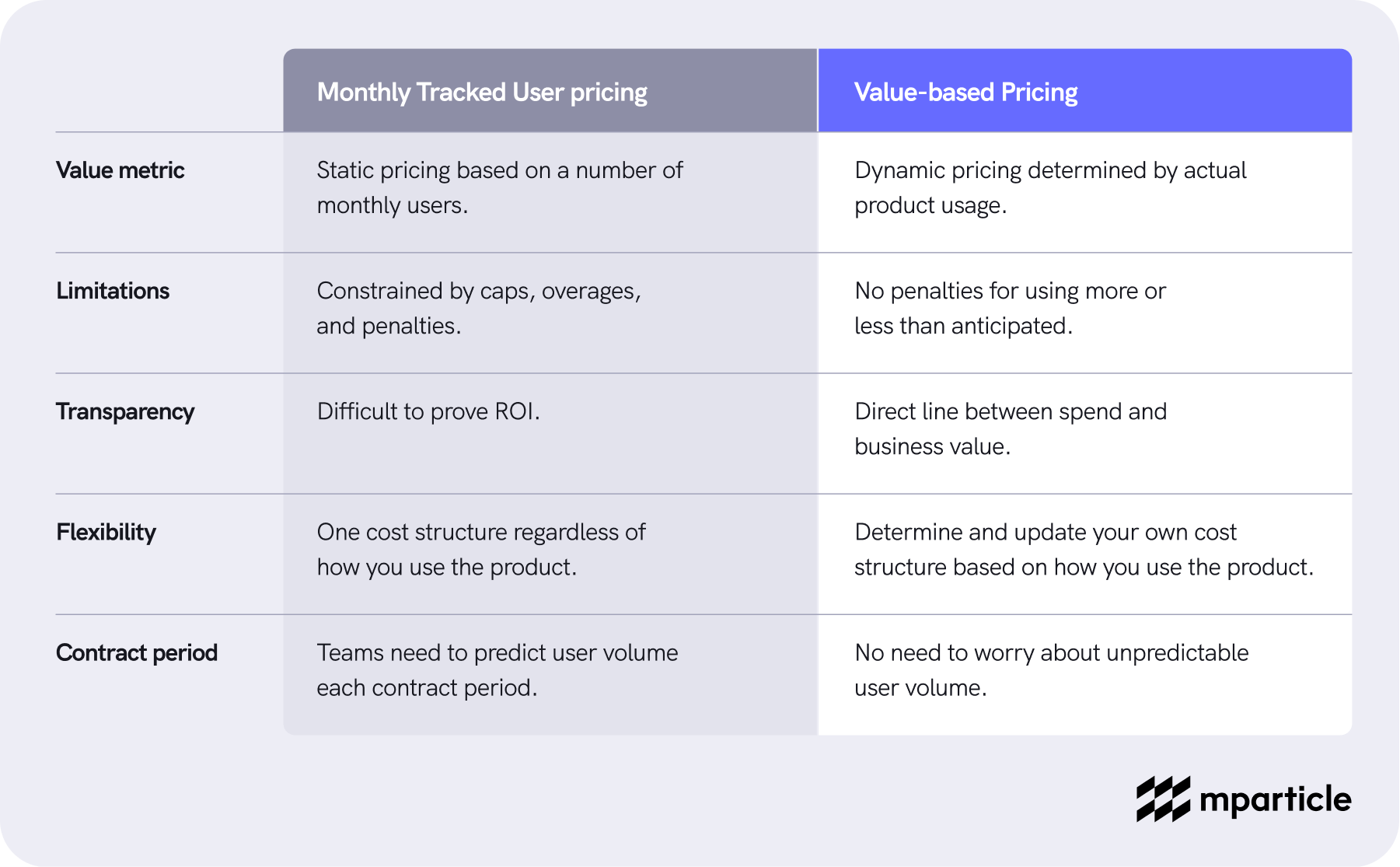It’s time to rethink CDP pricing
In today’s unpredictable economic climate, traditional CDP pricing can be inflexible for marketing and data teams. Let’s explore the mechanics of several popular CDP pricing models, and discuss the pros and cons of each approach.

Is your marketing budget under more scrutiny this year? 67% of CFOs now believe that digital spending over the past three years has not met enterprise expectations. It’s therefore no surprise that when looking for ways to optimize company spend, CFOs are placing particularly high scrutiny on MarTech. In fact, Gartner’s 2023 CMO Spend and Strategy survey found that 75% of marketing leaders are under pressure to optimize their MarTech spend and increase ROI.
Aligning the value of a tool with its cost is not always easy, however. Under many SaaS pricing models today, companies pay for a set number of units (like number of users or data points processed) within a given contract period. If usage exceeds these limits, customers pay a penalty. If usage falls below the limit, customers waste their budget on underutilization. This poses a challenge, even in the best of economic times. It's difficult to predict how users will interact on a week-to-week basis in today's complex market, let alone over a 12-month contract period.
Traditional CDP pricing uses the wrong value metrics
CDPs, in particular, represent a major investment for enterprise organizations. To optimize their CDP investment, brands need the flexibility to align costs to their CDP use cases, and to adjust those costs and use cases change over time. The pricing structures employed by the vast majority of CDP vendors, however, make it difficult to do so.
Let’s take a quick look at the two most common value metrics used in CDP pricing today.
Monthly tracked users
Many CDPs charge based on the monthly tracked users (MTUs). In addition to the fact that using more or less than your monthly limit can result in wasteful spending, MTU-based plans also treat every user as though they represent equal value to your company. In reality, however, this is far from true. A loyal repeat customer who can be counted on for several purchases each month clearly delivers much more value than someone who accidentally clicked on a Facebook ad and abandoned their session immediately. Using MTUs as a sole value metric forces companies to overpay for high volumes of lower-value users, divorcing CDP spend from business value.
Event-based pricing
Event-based pricing models have gained traction as an alternative model to MTUs, as they allow teams align costs with their CDP usage more closely. But just like users, not all events are created equal. For example, a session event that is immediately ended is not as valuable as an “abandoned cart” event that enables you to trigger a personalized reminder email that generates to a purchase. Under most event-based pricing models, low-value events cost the same as high-value events, leading to inefficient spend.
Bringing CDP pricing in line with business value requires moving away from rigid value metrics to a flexible framework that scales price with a brand’s evolving needs.
What is Value-based Pricing?
Value-based Pricing is mParticle’s new pricing model that aligns costs directly to the value companies receive from their CDP. It progresses beyond one-size-fits-all pricing models, and allows teams to compose a customized data stack that fits their unique needs.
By adopting a credit system and usage-based pricing structure, customers pay for the services that they use in a given period, and never more. Customers can also have the flexibility to control how data is stored and processed in mParticle to optimize their storage and cost efficiency.
With mParticle’s new pricing model, we have improved the efficiency of our platform costs without sacrificing usage and value. The ability to tier our events and optimize our costs as our data volumes continue to grow is critical for delivering impactful customer experiences at scale.
Senior Director of Data at Equinox
Value-based Pricing benefits brands in several key ways.
No more overage penalties and wasted budget
There’s no need to worry about how fluctuating user activity might impact your monthly spend. With no caps on monthly users or limits on events, you’ll never have to pay more when your usage exceeds your expectations, or waste budget when it falls short.
Improved flexibility and control
With the ability to control how your data is processed based on your use cases, you can ensure that your CDP spend stays aligned to the way you actually leverage your data.
Futureproof your data stack
As your business grows and evolves, your data stack will, too. Value-based pricing gives you the flexibility to compose a stack that fits your business needs today with the confidence that you can easily adapt to your needs tomorrow.
MTUs vs. VBP: A side-by-side comparison
Let’s take a closer look at some key ways in which value-based pricing differs from the traditional model.

Visit our pricing page to learn more about how mParticle’s value-based pricing model can help you align your martech spend to business value.
Latest from mParticle
Try out mParticle
See how leading multi-channel consumer brands solve E2E customer data challenges with a real-time customer data platform.
Startups can now receive up to one year of complimentary access to mParticle. Receive access




